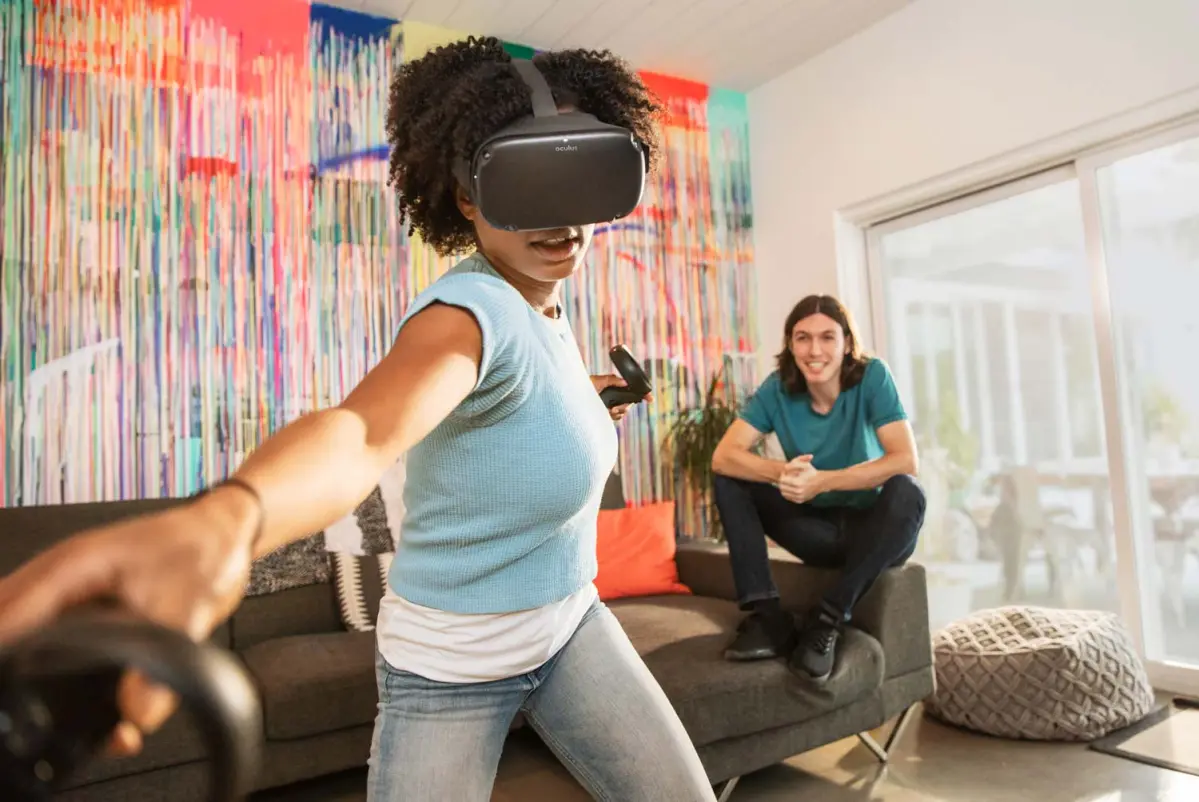Since as far back as the early 1990s, major electronics companies have wanted to take virtual reality mainstream. A futuristic vision of digital entertainment dreamt up in sci-fi novels fifty years earlier, it was hoped at the time that this unique medium would capture the imagination of consumers and prove the next big thing. Gimmick headsets such as Nintendo’s Virtual Boy and Sega VR, however, were doomed to fail before they even launched; the technology simply hadn’t caught up to the vision. The headsets were clunky and the experiences underwhelming.
But thirty years on and the future has arrived: From Batman simulators to lightsaber-wielding rhythm games, VR is offering experiences that realize that original conception.
And yet, for all the excitement over its potential, VR is struggling to penetrate the mainstream. Eight years on from the first Oculus headset there’s still no sign of any watershed moment to see it explode onto the scene.
The momentum generated by initial hype has slowed to a trickle — not quite treading water, but hardly moving forward at the sort of breakneck pace that has defined the tech space for the past two decades.
VR’s struggle to gain traction now poses a real conundrum for interested parties looking to enter the market: quality software is needed to attract consumers, but how does one justify developing for a platform that isn’t being used by all that many people and presumably won’t give you an acceptable return on investment?
Presently, a huge pool of potential consumers just don’t know or understand the VR medium — how the hardware operates, what sort of experience it offers, and why it’s worth spending money on over devices like smartphones and conventional PCs.
Even for those who are up to speed with VR, the longer the tech takes to produce a killer app or breakthrough piece of hardware the more the narrative shifts from trend-setter to a novelty peripheral.
Of course, VR certainly has a community of passionate supporters, both on the consumer and developer side. And with powerhouse electronics and technology firms like Google, Facebook, and Valve willing to go gangbusters to try and push the technology forward, VR isn’t going away anytime soon.
But for the brave few developers who have been pioneering software for the VR platform, what are the creative and financial rewards for right now? And in their eyes, looking forward, what are its best prospects of cracking the mainstream in 2020?

The Creative Appeal
“It’s an opportunity to break through and create something unique,” says Paul Crabb, technical director at developer/publisher Coatsink, a UK company that has produced several games under the Oculus Studios banner.
He explains to me that for new companies “VR is a great way to try and carve out your own niche,” going on to outline that while innovating new ideas is still possible in conventional games, there’s less room for it and far more competition.
Inxile Entertainment’s Brian Fargo, a developer with a 30-year long track record of producing quality video games that includes the studio’s first VR project, The Mage’s Tale, is similarly drawn to this notion of pioneering development for a new medium.
He recalled his first encounter with the platform when speaking with Twinfinite last year:
“I was immediately intrigued by VR when I first experienced it, and I wanted to experiment with a new medium and all its unique attributes. The first time I tried a video game back in the ‘80s I got a rush and thought about all the ways I could use the medium to bring our D&D dungeon crawling fantasies to life. VR gave me that same rush”
Fargo later added that “creating experiences with new concepts and approaches is quite appealing to creative people.”
When Twinfinite asked Sebastian Strand, producer and lead Programmer at Zoink Games, an independent developer working closely with Sony to make PSVR exclusives, he too remembers being struck by an enthusiasm for “exploring this new, exciting playspace before anyone else” and working without the constraints of “an established ruleset.”

Another of the key takeaways echoed by virtually everyone I’ve spoken to working in the VR space is that beyond the intrigue of the technology itself, it’s the tight-knit community of developers and the level of support on offer that makes this budding new industry segment all the more appealing.
“[There’s] collaboration and camaraderie between the developers [that is] unique to VR,” Paul Crabb from Coatsink said when I ask him about how the team has coped with overcoming technical challenges. He then went on to explain:
“Everyone is super willing to share all the solutions and experiments they’ve found, and so there’s no one solution that can be attributed to any one company. Everyone has been pitching together and helping each other out with the amazing discoveries they’ve found.”
And for those working closely with Oculus, the publisher itself has been on hand to help with development. Brian Fargo talked up Oculus’ commitment to helping developers quickly get to grips with the hardware:
“Oculus Studios provided us with a ton of help, with other titles to play, direct guidance from Oculus staff, early versions of prototype products, and on some occasions even connected us up with other Oculus Studio teams to give us detailed explanations on how they implemented certain features.”
Zoink Games’ Sebastian Strand was complimentary of Sony’s assistance through his team’s dealings, too, talking up their willingness to trust the team and provide free reign to “do their own thing.”
Financial Risks
It’s clear that for the VR hardware publishers keen to support their headsets with as much content as possible, it’s in their best interest to offer as much assistance as is necessary. Importantly, too, to loosen the reins and just see what comes of giving these third-party studios carte blanche to go and create. Based on that alone, it’s easy to understand why that’s a huge incentive for developers from a creative standpoint.
Still, there’s a worrisome financial risk associated with making the jump to VR development that’s understandably off-putting for many. It’s an issue at the very heart of what’s halted VR’s momentum in its tracks, which was voiced by several respondents to XRDC’s annual VR and AR market survey back in August of 2019.
“Funding is plentiful, but most of the money gets swallowed up by the largest corporations,” one said, who went on to lament that “unfortunately, small and medium-sized companies are growing by acquisition into larger companies rather than solo development.”
Another mooted:
“small and medium companies shoulder such a large amount of the risks to bring a product to market. It would be great to have some capital or resources to bring visibility to these smaller projects before they are selling off company assets.”
Despite this, the developers I’ve spoken with are all quite pleased with the financial results from the various VR projects they’ve been involved with. Coatsink told Twinfinite that results “vastly exceeded” expectations. Other interviewees seemed quite pleased with returns, too, even in comparison to the performance of conventional games they’d released.
Not all developers are having the same luck, of course, and it’s worth noting that these were all companies that have been working somewhat closely with publishers like Oculus and Sony — publishers interested in making sure their VR ecosystems are being supported with new content and thus perhaps with a keener interest in looking after the studios developing for them.
The Paradox of New Technology
So what about the wider picture in terms of market viability: When does VR arrive as a segment of the games industry able to entice developers not just from a creative standpoint but because there’s potential for real growth? How much of an obstacle are issues such as limited accessibility, price point, and the public’s perception of the medium, and what’s on the horizon that looks likely to solve it?
Paul from Coatsink sums up what he calls the “paradox of new tech.”
“You need the user base to attract the developers to make the killer apps, and the killer apps need to be there to attract the user base, right? That’s going to be the same on all kinds of new tech. But the solution to that is time and investment and… faith, really.”
Zoink’s Sebastian Strand also echoes that VR’s progress is hindered by issues with both software and hardware.
“VR as a market is a mixed bag. It’s fairly small, but it has avid fans. You get a lot of coverage for free that way, but then again, you might not end up reaching as many people as you would with a conventional game.
VR does not quite have a killer app yet, so that’s a software issue. Generally people don’t “get” VR until they’ve tried it, but then they’re completely sold once they have. If VR could get a Wii Sports and move hardware that way, I think that could open people’s eyes to it. Once it does it just has to reach critical mass before it becomes mainstream.”
Equally, though, Strand says that hardware is also a big part of the issue:
“Moving towards wireless is a must, and the cost needs to come down. I think PSVR was a really smart move for Sony, making it an affordable option; if you already had a PS4, Move controllers and a camera, all you had to buy was the headset. I do wish there were fewer wires involved, though.”
Oculus Quest to Break the Deadlock?
The cumbersome nature of tethered headsets is a big reason why Oculus Quest has the VR community excited. Launched in May of last year, Quest offers the long-awaited untethered VR experience at a reasonably affordable price (around $499). It’s been a hit among developers and critics, and it’s being tipped to potentially reshape the market landscape moving forward as a result.
Brian Fargo said that while VR “has been an enthusiast market until now [he thinks] we’re going to see that change rapidly as products like the Oculus Quest, which doesn’t have a big PC hardware investment needed, and full freedom of movement without cables, as the real turning point.” He also added that “Oculus has been thrilled with the software units being sold on the Quest.”

Coatsink COO Eddie Beardsmore also believes Quest is “the perfect device for getting the mainstream. It’s cheap, easy to use, and really fast to just get into VR,” while Paul Crabb reasons:
“In the age we live in, we’re so used to having information and entertainment straight away. If you think about devices like a mobile phone, and how the Nintendo Switch has become successful, it is because of this instant access to entertainment. Quest finally offers that functionality for VR users.”
Certainly, a likening of Quest’s accessibility to VR with that of the convenience afforded to players by smartphones and Nintendo Switch is a pertinent one. It’s a reminder that commercial success doesn’t always necessitate pushing the bleeding edge of performance. In the case of VR, contrary to conventional wisdom, it seems that absolute image fidelity may actually matter far less to the immersion of the experience than being wireless.
Quest’s impact also had XRDC respondents optimistic as a device that could “jumpstart the market.” The company’s most recent survey was particularly notable for being the first that recorded more respondents developing for Oculus than HTC headsets, with Quest comprising 28% of all development projects for those that participated in the survey, even after having only been on the market for three months at the time.
It will be fascinating to see the numbers again when XRDC’s 2020 survey releases in four months’ time.
More recently, the Game Developer Conference’s annual survey revealed a growing belief amongst developers in VR as a viable gaming platform, with Oculus Quest leading the way as the headset that most interested the 4,000 survey respondents.
Working Around Nausea
Of course, in VR development, limiting hardware specifications to save on costs carries different implications from conventional games: excellent visual fidelity and a high, stable frame-rate is critical to avoid inducing nausea that even those monsters who can read in a moving car going down a winding road — the sorts with steel stomachs — struggle to grin and bear.
Inxile’s David Rogers explains that “maintaining 90 frames per second is a big deal when doing VR development.” In the case of The Mage’s Tale, there were apparently “a lot of cool, big, and expensive VFX techniques” the team had to shelve because they were “simply too intense to run at 90 FPS.”

Sebastian Strand explained that “one drawback (with PSVR) was the frame rate requirement in relation to the hardware. It’s always important to keep a steady frame rate, but in VR the player will literally throw up if you don’t do that. The base PS4 is a great console, but it’s starting to age.”
In the case of Oculus Quest, the headset is notable for it not making too many compromises in offering the all-important wireless functionality. Featuring the same 6DOF motion tracking, identical controls and actually packing a higher resolution as its Rift sister, it’s capable of running all but the most demanding VR games with relative parity.
Indeed, while Quest certainly isn’t the Rolls Royce VR headset experience, it does pack just enough power to run the platform’s best games, including one, in particular, that might prove key in 2020…
Finally, A Killer App?
While the VR platform has already produced plenty of quality software, it is in the past 12 months that we’ve seen a handful of games boast commercial success to rival those designed for conventional gaming platforms.

Beat Saber, Superhot, and recently Boneworks have demonstrated there is serious money to be earned in a very short period of time. Beat Saber was the first VR game to hit one million copies sold; Superhot’s VR version generated around $2 million over the 2019 Holiday period; Boneworks launched only weeks ago and is already estimated to have earned over $3 million.
Notably, too, Beat Saber, which is perhaps the closest thing VR has to a killer app, has been a hit with streamers and YouTubers, too. One cannot underestimate the role that influencers play in attracting new audiences through entertainment these days.
The biggest noise in VR, though, might be yet to come in 2020. The recent announcement of Half-Life: Alyx marks the return of a beloved, iconic IP long dreamed of by PC players — though, few would have picked the franchise to make its big return as a VR title.
Publisher and developer Valve’s decision to use Half-Life to push its VR hardware isn’t one that’s likely to have been universally appreciated, but it’s likely going to be effective in producing the desired result. Valve’s Index headset is already sold out in 31 countries ahead of Alyx’s launch, in fact
Importantly, if Alyx is a critical success, it going to play a crucial role in legitimizing VR as a hardcore gaming platform in the eyes of those who still perceive it as a novelty peripheral.

Ironically, while Valve’s primary motivation for developing a VR game is to push its own Index headset, the big winner in all this might yet be Oculus Quest. That’s because Alyx is not actually exclusive to Valve hardware; it will be playable on Quest, as well as a number of other PC headsets.
A Matter of When Not If
For industry analysts, both Oculus Quest and Half-Life: Alyx are tipped as the decisive factors likely to take VR to the next level of market penetration.
Offering her 2020 video game industry predictions to Gamesindustry.biz only just the other week, SuperData’s Stephania Llamas believes Oculus Quest will sell 1.8M devices this year, highlighting that “Quest offers the untethered experience that people have been waiting for,” which she thinks should see another two or three million units sold in 2020 — a very respectable tally indeed, even if doesn’t quite represent a total conquering of the masses.
The NPD Group’s Matt Piscatella, meanwhile, said “Growth in Oculus Quest, the release of Half-Life: Alyx, and likely reinvigorated marketing and content for PSVR should at long last bring immersive gaming VR to notable market traction.”
So while 2020 doesn’t look set to be the year of mass-market adoption, it seems the market is moving closer to solving two major parts of the “paradox of new tech.”
Quest is making quality VR accessible, and the arrival of AAA marquee VR titles from esteemed developers like Valve might finally change the narrative of the platform from a novelty to a must-have gaming device. 2020 may yet be remembered as a transitional year when VR’s mainstream success was teed up by two important pieces of hardware and software.





Published: Jan 29, 2020 08:00 am